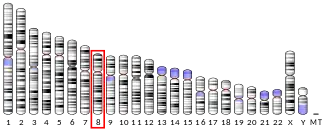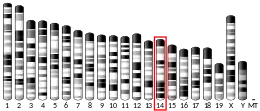Death receptor 4 (DR4), also known as TRAIL receptor 1 (TRAILR1) and tumor necrosis factor receptor superfamily member 10A (TNFRSF10A), is a cell surface receptor of the TNF-receptor superfamily that binds TRAIL and mediates apoptosis.[5][6]
Function
The protein encoded by this gene is a member of the TNF-receptor superfamily. This receptor is activated by tumor necrosis factor-related apoptosis inducing ligand (TNFSF10/TRAIL), and thus transduces cell death signal and induces cell apoptosis.[7]
Studies with FADD-deficient mice suggested that FADD, a death domain containing adaptor protein, is required for the apoptosis mediated by this protein.[8]
Interactions
References
- 1 2 3 GRCh38: Ensembl release 89: ENSG00000104689 - Ensembl, May 2017
- 1 2 3 GRCm38: Ensembl release 89: ENSMUSG00000022074 - Ensembl, May 2017
- ↑ "Human PubMed Reference:". National Center for Biotechnology Information, U.S. National Library of Medicine.
- ↑ "Mouse PubMed Reference:". National Center for Biotechnology Information, U.S. National Library of Medicine.
- ↑ Walczak H, Degli-Esposti MA, Johnson RS, Smolak PJ, Waugh JY, Boiani N, Timour MS, Gerhart MJ, Schooley KA, Smith CA, Goodwin RG, Rauch CT (Dec 1997). "TRAIL-R2: a novel apoptosis-mediating receptor for TRAIL". EMBO J. 16 (17): 5386–97. doi:10.1093/emboj/16.17.5386. PMC 1170170. PMID 9311998.
- ↑ Pan G, O'Rourke K, Chinnaiyan AM, Gentz R, Ebner R, Ni J, Dixit VM (April 1997). "The receptor for the cytotoxic ligand TRAIL". Science. 276 (5309): 111–3. doi:10.1126/science.276.5309.111. PMID 9082980. S2CID 19984057.
- ↑ "Entrez Gene: TNFRSF10A tumor necrosis factor receptor superfamily, member 10a".
- ↑ Kuang AA, Diehl GE, Zhang J, Winoto A (2000). "FADD is required for DR4- and DR5-mediated apoptosis: lack of trail-induced apoptosis in FADD-deficient mouse embryonic fibroblasts". J. Biol. Chem. 275 (33): 25065–8. doi:10.1074/jbc.C000284200. PMID 10862756.
- ↑ Miyazaki T, Reed J C (June 2001). "A GTP-binding adapter protein couples TRAIL receptors to apoptosis-inducing proteins". Nat. Immunol. 2 (6): 493–500. doi:10.1038/88684. ISSN 1529-2908. PMID 11376335. S2CID 6923467.
Further reading
- Kimberley FC, Screaton GR (2005). "Following a TRAIL: update on a ligand and its five receptors". Cell Res. 14 (5): 359–72. doi:10.1038/sj.cr.7290236. PMID 15538968.
- Fleury S, Thibodeau J, Croteau G, et al. (1995). "HLA-DR polymorphism affects the interaction with CD4". J. Exp. Med. 182 (3): 733–41. doi:10.1084/jem.182.3.733. PMC 2192178. PMID 7650480.
- MacFarlane M, Ahmad M, Srinivasula SM, et al. (1997). "Identification and molecular cloning of two novel receptors for the cytotoxic ligand TRAIL". J. Biol. Chem. 272 (41): 25417–20. doi:10.1074/jbc.272.41.25417. PMID 9325248.
- Schneider P, Bodmer JL, Thome M, et al. (1997). "Characterization of two receptors for TRAIL" (PDF). FEBS Lett. 416 (3): 329–34. doi:10.1016/S0014-5793(97)01231-3. PMID 9373179. S2CID 83145771.
- Marsters SA, Sheridan JP, Pitti RM, et al. (1998). "A novel receptor for Apo2L/TRAIL contains a truncated death domain". Curr. Biol. 7 (12): 1003–6. doi:10.1016/S0960-9822(06)00422-2. PMID 9382840. S2CID 21645158.
- Chaudhary PM, Eby M, Jasmin A, et al. (1998). "Death receptor 5, a new member of the TNFR family, and DR4 induce FADD-dependent apoptosis and activate the NF-kappaB pathway". Immunity. 7 (6): 821–30. doi:10.1016/S1074-7613(00)80400-8. PMID 9430227.
- Schneider P, Thome M, Burns K, et al. (1998). "TRAIL receptors 1 (DR4) and 2 (DR5) signal FADD-dependent apoptosis and activate NF-kappaB". Immunity. 7 (6): 831–6. doi:10.1016/S1074-7613(00)80401-X. PMID 9430228.
- Diab BY, Lambert NC, L'Faqihi FE, et al. (1999). "Human collagen II peptide 256-271 preferentially binds to HLA-DR molecules associated with susceptibility to rheumatoid arthritis". Immunogenetics. 49 (1): 36–44. doi:10.1007/s002510050461. PMID 9811967. S2CID 22393348.
- Costanzo A, Guiet C, Vito P (1999). "c-E10 is a caspase-recruiting domain-containing protein that interacts with components of death receptors signaling pathway and activates nuclear factor-kappaB". J. Biol. Chem. 274 (29): 20127–32. doi:10.1074/jbc.274.29.20127. PMID 10400625.
- Hymowitz SG, Christinger HW, Fuh G, et al. (1999). "Triggering cell death: the crystal structure of Apo2L/TRAIL in a complex with death receptor 5". Mol. Cell. 4 (4): 563–71. doi:10.1016/S1097-2765(00)80207-5. PMID 10549288.
- Gibson SB, Oyer R, Spalding AC, et al. (2000). "Increased expression of death receptors 4 and 5 synergizes the apoptosis response to combined treatment with etoposide and TRAIL". Mol. Cell. Biol. 20 (1): 205–12. doi:10.1128/MCB.20.1.205-212.2000. PMC 85076. PMID 10594023.
- Miyazaki T, Reed JC (2001). "A GTP-binding adapter protein couples TRAIL receptors to apoptosis-inducing proteins". Nat. Immunol. 2 (6): 493–500. doi:10.1038/88684. PMID 11376335. S2CID 6923467.
- Trauzold A, Wermann H, Arlt A, et al. (2001). "CD95 and TRAIL receptor-mediated activation of protein kinase C and NF-kappaB contributes to apoptosis resistance in ductal pancreatic adenocarcinoma cells". Oncogene. 20 (31): 4258–69. doi:10.1038/sj.onc.1204559. PMID 11464292.
- Dörr J, Bechmann I, Waiczies S, et al. (2002). "Lack of tumor necrosis factor-related apoptosis-inducing ligand but presence of its receptors in the human brain". J. Neurosci. 22 (4): RC209. doi:10.1523/JNEUROSCI.22-04-j0001.2002. PMC 6757573. PMID 11844843.
- Koyama S, Koike N, Adachi S (2002). "Expression of TNF-related apoptosis-inducing ligand (TRAIL) and its receptors in gastric carcinoma and tumor-infiltrating lymphocytes: a possible mechanism of immune evasion of the tumor". J. Cancer Res. Clin. Oncol. 128 (2): 73–9. doi:10.1007/s004320100292. PMID 11862476. S2CID 19509629.
- Guan B, Yue P, Lotan R, Sun SY (2002). "Evidence that the human death receptor 4 is regulated by activator protein 1". Oncogene. 21 (20): 3121–9. doi:10.1038/sj.onc.1205430. PMID 12082627. S2CID 6726601.
- Söderström TS, Poukkula M, Holmström TH, et al. (2002). "Mitogen-activated protein kinase/extracellular signal-regulated kinase signaling in activated T cells abrogates TRAIL-induced apoptosis upstream of the mitochondrial amplification loop and caspase-8". J. Immunol. 169 (6): 2851–60. doi:10.4049/jimmunol.169.6.2851. PMID 12218097.
This article is issued from Wikipedia. The text is licensed under Creative Commons - Attribution - Sharealike. Additional terms may apply for the media files.



